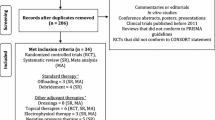Abstract
Background: Diabetic foot ulcers (DFUs) present a treatment challenge and result in a large economic burden, requiring careful evaluation of the clinical efficacy and cost effectiveness of new treatment modalities. DFU clinical trials of the bio-engineered skin substitute Apligraf® (Novartis Pharma AG, Basel, Switzerland) have demonstrated improved clinical efficacy compared with good wound care (GWC) alone.
Objective: To determine the economic impact and cost effectiveness of Apligraf® plus GWC compared with GWC alone in the treatment of DFUs.
Study perspective: Societal.
Methods: A Markov-based simulation model was created to compare the costs and effects of Apligraf® plus GWC to those of GWC alone over a 12-month period. The primary health states were ‘uninfected ulcer’, ‘infected ulcer’, ‘gangrene’, and ‘healed ulcer’. Transition probabilities were based on clinical trial results, while cost estimates were based on estimates of resource utilisation in the Netherlands. The cost-effectiveness outcome measures were the incremental cost per ulcer-free month gained and the incremental cost per amputation avoided.
Results: Costs in the first year of treatment were €4656 for Apligraf® plus GWC and €5310 for GWC alone (1999 values). Treatment with Apligraf® led to lower costs since its greater effectiveness offset the added cost of the product. This benefit was realised after 5 months, the crossover point of the two cost curves. Apligraf® use increased the amount of ulcer-free time by by 1.53 months (7.78 vs 6.25) and reduced the risk of amputation (6.3% vs 17.1%). Sensitivity analyses showed that cost parameters (e.g. units of Apligraf® required, cost of treatment practice) and transition probabilities between health states affected the cost results.
Conclusions: Treatment with Apligraf® plus GWC resulted in a 12% reduction in costs over the first year of treatment compared with GWC alone. The increased ulcer-free time coupled with a reduced risk of amputation to a large extent offset the initial costs of the product.









Similar content being viewed by others
Notes
The use of tradenames is for product identification purposes only and does not imply endorsement.
References
Moss SE, Klein R, Klein B. The prevalence and incidence of lower extremity amputation in a diabetic population. Arch Intern Med 1992; 152: 610–6
Reiber GE, Lipsky BA, Gibbons GW. The burden of diabetic foot ulcers. Am J Surg 1998; 176 (2A Suppl.): 5S–10S
Reiber G. Diabetic foot care: financial implications and practice guidelines. Diabetes Care 1992; 15 (1 Suppl.): 29–31
Apelqvist J, Ragnarson-Tennvall G, Persson U, et al. Diabetic foot ulcers in a multidisciplinary setting: an economic analysis of primary healing and healing with amputation. J Intern Med 1994; 235: 463–71
Apelqvist J, Ragnarson-Tennvall G, Larsson J, et al. Long-term costs for foot ulcers in diabetic patients in a multidisciplinary setting. Foot Ankle Int 1995; 16 (7): 388–94
Huse DM, Oster G, Killen AR, et al. The economic costs of non-insulin-dependent diabetes mellitus. JAMA 1989 Nov 17; 262 (19): 2708–13
Ollendorf DA, Kotsanos JG, Wishner WJ, et al. Potential economic benefits of lower-extremity amputation prevention strategies in diabetes. Diabetes Care 1998; 21 (8): 1240–5
Apelqvist J, Bakker K, van Houtum WH, et al., editors. International Working Group on the Diabetic Foot. International consensus on the diabetic foot. Maastricht: International Working Group on the Diabetic Foot, 1999
Veves A, Falanga V, Armstrong DG, et al. Graftskin, a human skin equivalent, is effective in the management of noninfected neuropathic diabetic foot ulcers: a prospective randomized multicenter clinical trial. Diabetes Care 2001; 24 (2): 290–5
Persson U, Willis M, Odegaard K, et al. The cost-effectiveness of treating diabetic lower extremity ulcers with Becaplermin (Regranex): a core model with an application using Swedish cost data. Value Health 2000; 3 (1 Suppl.): S39–46
Ghatnekar O, Persson U, Willis M, et al. Cost effectiveness of Becaplermin in the treatment of diabetic foot ulcers in four European countries. Pharmacoeconomics 2001; 19 (7): 767–78
Wagner Jr FW. The dysvascular foot: a system for diagnosis and treatment. Foot Ankle 1981; 2 (2): 64–122
Nabuurs M, van den Berg R, Redekop W, et al. Medical consumption and quality of life of diabetic foot patients in comparison to a background population. Diabetologia 2000 Aug; 43 (1 Suppl.): A224
van Houtum WH, Lavery LA, Harkless LB. The costs of diabetes-related lower-extremity amputations in the Netherlands. Diabet Med 1995; 12: 777–81
van Houtum WH, Lavery LA, Harkless LB. The impact of diabetes-related lower-extremity amputations in the Netherlands. J Diabetes Complications 1996; 10 (6): 325–30
Brem H, Balledux J, Bloom T, et al. Healing of diabetic foot ulcers and pressure ulcers with human skin equivalent: a new paradigm in wound healing. Arch Surg 2000; 135: 627–34
Allenet B, Parée F, Lebrun T, et al. Cost-effectiveness modeling of Dermagraft® for the treatment of diabetic foot ulcers in the French context. Diabete Metab 2000; 26 (2): 125–32
Acknowledgements
Funding for this study was provided by Novartis Pharma AG, Basel, Switzerland. Kornelia Lovas and Zoltan Kalo are employees of Novartis Pharma AG, Basel, Switzerland.
Author information
Authors and Affiliations
Corresponding author
Rights and permissions
About this article
Cite this article
Redekop, W.K., McDonnell, J., Verboom, P. et al. The cost effectiveness of Apligraf® treatment of diabetic foot ulcers. Pharmacoeconomic 21, 1171–1183 (2003). https://doi.org/10.2165/00019053-200321160-00003
Published:
Issue Date:
DOI: https://doi.org/10.2165/00019053-200321160-00003




